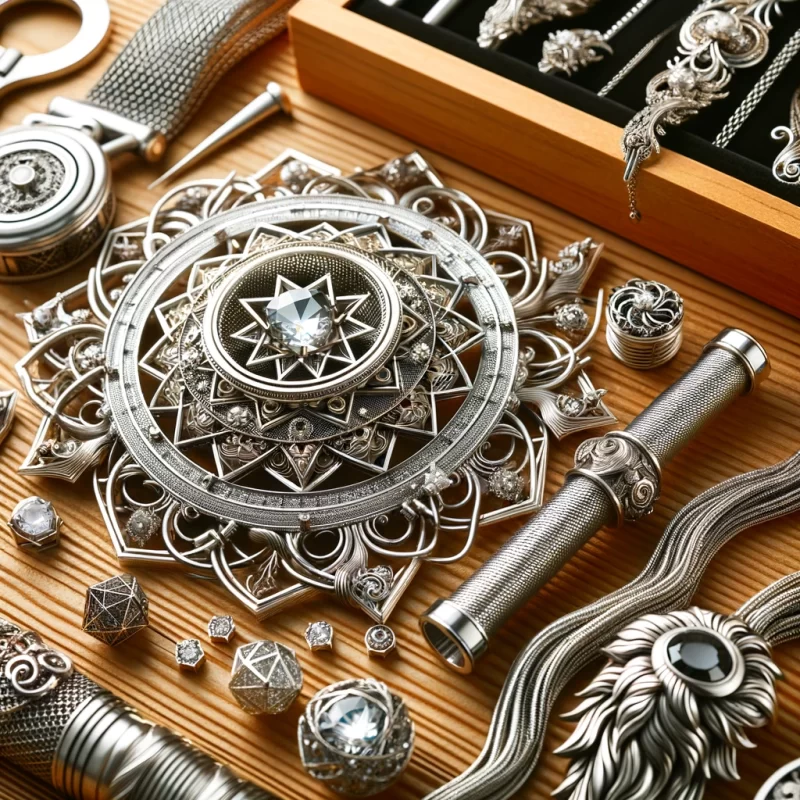
内容目录
When it comes to sourcing materials that stand at the forefront of technology and innovation, carbon fiber is undoubtedly a shining star. Its strength-to-weight ratio is unmatched, and its versatility in applications ranging from aerospace to luxury jewelry makes it a sought-after commodity. However, the crux of leveraging carbon fiber’s exceptional qualities lies in choosing the right supplier. Let me walk you through this, step by step, ensuring you make an informed decision that aligns with your business needs.
Choosing the right carbon fiber supplier is more than a transaction; it’s a partnership. In the bustling markets of Europe and America, where my business thrives on providing top-notch stainless steel and carbon fiber jewelry, understanding the nuances of a good supplier relationship is key. The right supplier doesn’t just provide a product; they provide reliability, quality assurance, and innovation that can significantly uplift your product line.
So, how do you sift through the myriad of suppliers out there and pick one that’s a perfect match for your business ethos and requirements?
Identifying Your Specific Needs and Quality Standards
Before even beginning to look for a supplier, it’s essential to have a clear understanding of your specific needs. What applications are you looking at for carbon fiber? Are we talking about high-end jewelry that combines carbon fiber with precious metals and stones? Or is it more about creating statement pieces that showcase the material’s natural beauty and strength? Each application might require different grades of carbon fiber, varying weave patterns, or specific finishing techniques.
Quality standards cannot be compromised. As someone who has navigated the complex markets of Europe and America, I can attest to the fact that our clients – whether they’re big names like Walmart or niche boutique stores – expect nothing less than excellence. Your carbon fiber supplier should be able to meet, if not exceed, these standards. They should provide comprehensive data on their material’s tensile strength, stiffness, and durability, ensuring their product can stand the test of time and usage.
Evaluating Supplier Reliability and Innovation
When we talk about reliability in a carbon fiber supplier, we’re looking at more than just their ability to deliver on time. It’s about the consistency of the product quality, their responsiveness to your queries and concerns, and their capacity to maintain supply even in challenging circumstances. In the fast-paced world of jewelry design, especially when dealing with materials as sophisticated as carbon fiber, having a supplier that can keep pace with your demand without compromising on quality is non-negotiable.
Innovation is another critical factor. The carbon fiber industry is continuously evolving, with new technologies and manufacturing processes emerging regularly. A supplier who stays at the cutting edge of these developments can offer you more than just materials; they can provide insights into new possibilities and applications for carbon fiber in your product line. They can become a valuable resource for pushing your designs to the next level, making your products stand out in the competitive markets of Europe and America.
Cost Considerations Without Compromising Quality
Let’s talk numbers. Choosing a supplier isn’t just about finding the highest quality product; it’s also about ensuring that the cost aligns with your budget and pricing strategy. However, in the realm of carbon fiber, opting for the cheapest option can often lead to compromised quality. The trick is to find a balance – a supplier who offers competitive pricing without cutting corners on the material’s performance and consistency.
Negotiating favorable terms with your carbon fiber supplier can make a significant difference. Look for suppliers willing to work with you on pricing for bulk orders or long-term contracts. It’s also worth discussing options for exclusivity or first access to new materials and technologies, giving you an edge over competitors.
The Importance of Sustainability in Your Supply Chain
In today’s market, sustainability is not just a buzzword; it’s a business imperative, especially for industries like jewelry, where consumers are increasingly conscious of the environmental impact of their purchases. A carbon fiber supplier that prioritizes eco-friendly manufacturing processes and recycling of carbon fiber waste not only aligns with these consumer values but also positions your business as a responsible brand in the global market.
Sustainability practices within the supply chain can range from energy-efficient manufacturing to programs for recycling and reusing carbon fiber scraps. Partnering with a supplier that is committed to reducing environmental impact can enhance your brand’s reputation and appeal to the eco-conscious consumer, especially in markets like Europe and America, where such considerations can significantly influence buying decisions.
Choosing the right carbon fiber supplier is a multifaceted process that involves careful consideration of quality, reliability, cost, innovation, and sustainability. By prioritizing these factors, you can establish a fruitful partnership that not only meets your current needs but also supports your business’s growth and evolution in the competitive landscape of luxury jewelry.
Case Study 1: Revolutionizing Engagement Rings with Carbon Fiber
Background: A luxury jewelry designer, specializing in engagement rings, sought to differentiate their product line by incorporating modern materials into traditional designs. The objective was to offer couples a unique blend of durability and elegance, reflecting the strength and beauty of their commitment.
Challenge: The main challenge was finding a carbon fiber supplier that could provide a material that was not only strong and lightweight but also capable of being crafted into intricate designs without losing its luster or integrity over time.
Solution: After extensive research and several discussions, the designer partnered with a supplier known for their innovative approach to carbon fiber manufacturing. This supplier utilized a proprietary weaving process that allowed for more delicate and detailed patterns, ideal for fine jewelry.
Outcome: The new line of engagement rings was a market hit, appealing to modern couples looking for unique, meaningful, and durable symbols of their love. The partnership not only resulted in a product that stood out from the competition but also established the designer as a pioneer in the use of modern materials in traditional jewelry making.
Case Study 2: Elevating Fashion Jewelry with Carbon Fiber Accents
Background: A fashion jewelry brand aimed to captivate a younger, style-conscious demographic by integrating high-tech materials into its designs. The goal was to blend the aesthetic appeal of traditional metals and gemstones with the cutting-edge allure of carbon fiber.
Challenge: The challenge lay in sourcing carbon fiber that could be dyed or treated to complement a wide range of colors and textures, enhancing the versatility and appeal of the jewelry collection.
Solution: The brand collaborated with a carbon fiber supplier specializing in customizable finishes and colors. This partnership enabled the brand to experiment with various hues and finishes, achieving a perfect balance between the traditional charm of jewelry and the modern edge of carbon fiber.
Outcome: The collection was a resounding success, attracting attention for its innovative use of materials and appealing to consumers eager for jewelry that made a statement. The brand solidified its reputation for creativity and innovation, attracting a loyal following among fashion-forward individuals.
These case studies illustrate the importance of a thoughtful and strategic approach to selecting carbon fiber suppliers. By prioritizing compatibility with business goals, commitment to quality, and willingness to innovate, businesses can forge partnerships that drive product innovation, market differentiation, and sustainable growth.
Reflecting on these case studies, it becomes clear that the right supplier relationship can transform a product line, setting a brand apart in the crowded marketplace. Whether it’s creating a new category of engagement rings or redefining fashion jewelry, the use of carbon fiber, backed by a strong supplier partnership, can lead to remarkable outcomes.
Case Study 1: A Small Jewelry Brand’s Strategic Partnership
Imagine a small but ambitious jewelry brand specializing in avant-garde designs. Recognizing the potential of carbon fiber to set their collections apart, the brand seeks a supplier capable of providing high-quality, customizable carbon fiber materials. Through diligent research and negotiations, they find a supplier with a robust R&D department willing to collaborate on unique carbon fiber weaves and finishes.
Key Steps to Success:
- Thorough Research: They started with an extensive search, focusing on suppliers with a track record of innovation in carbon fiber.
- Open Communication: From the outset, they were clear about their design needs, quality standards, and the importance of uniqueness in their products.
- Shared Vision: They selected a supplier that was not just looking for a client but a partner in innovation, willing to push the boundaries of carbon fiber applications in jewelry.
- Trial Projects: Before entering a long-term contract, they engaged in smaller projects to test the working relationship, quality consistency, and the supplier’s responsiveness to feedback.
Case Study 2: Enhancing Sustainability in the Supply Chain
A mid-sized jewelry manufacturer decided to prioritize sustainability in their product line, including the integration of carbon fiber. The challenge was to find a supplier that not only met their quality standards but also their commitment to environmental responsibility. After several rounds of discussions, they partnered with a supplier that utilized recycled carbon fiber and employed green manufacturing processes.
Key Steps to Success:
- Sustainability Criteria: The manufacturer defined specific sustainability criteria for their suppliers, including the use of recycled materials and energy-efficient processes.
- Collaborative Efforts: They worked closely with the supplier to understand the environmental impact of their production process and explored ways to minimize it together.
- Marketing Collaboration: Recognizing the marketing value of sustainability, the partnership also involved co-branding efforts to highlight their joint commitment to environmentally friendly practices.
- Continuous Improvement: The partnership was structured around ongoing dialogue and improvements, ensuring that the sustainability goals were not just met but continually advanced.
Forging Successful Partnerships: Best Practices
Define Clear Objectives: Know what you want from the partnership beyond the basic supply of materials. Whether it’s innovation, sustainability, or customization, having clear goals helps in selecting the right partner.
Due Diligence: Conduct thorough research on potential suppliers. Look beyond the sales pitches to understand their capabilities, track record, and the experiences of other clients.
Build Relationships: Focus on building a relationship rather than just conducting transactions. Mutual respect and understanding can lead to better collaboration and innovation.
Flexibility and Scalability: Choose a supplier that can adapt to your changing needs and scale up as your business grows. Flexibility in order fulfillment and responsiveness to market trends are key factors.
Regular Reviews and Communication: Establish a routine for reviewing the partnership’s performance, including quality, delivery times, and responsiveness to feedback. Open lines of communication ensure that any issues are promptly addressed and that the partnership evolves positively.
Through these case studies and best practices, it’s evident that forging a successful partnership with a carbon fiber supplier requires a strategic approach, focusing on shared goals, transparency, and a commitment to growth and innovation. Whether you’re a small brand or a larger enterprise, these principles can guide you in establishing a relationship that not only meets your current needs but also supports your long-term aspirations in the dynamic world of luxury jewelry.
The Future of Carbon Fiber in Luxury Jewelry
The trajectory of carbon fiber in the luxury jewelry market is set to ascend as designers and manufacturers continue to uncover its vast potential. With advancements in manufacturing technologies and a growing emphasis on sustainable luxury, carbon fiber’s appeal is expanding beyond its traditional boundaries.
Emerging Trends: One of the most exciting trends is the fusion of carbon fiber with traditional and precious materials, such as gold, silver, and diamonds. This juxtaposition not only highlights the sleek, modern aesthetic of carbon fiber but also adds a layer of luxury and exclusivity. Furthermore, the rise of customizable and personalized jewelry, where clients can have input into the design process, is seeing carbon fiber being used in innovative ways to cater to individual tastes and preferences.
Technological Advancements: The development of new weaving techniques and finishes for carbon fiber is pushing the boundaries of what’s possible in jewelry design. Techniques that allow for more intricate patterns, color infusions, and even luminescent qualities are making carbon fiber jewelry more versatile and appealing to a broader audience.
Sustainability and Ethical Considerations: As the global consciousness around sustainability grows, so does the demand for materials and processes that have a lower environmental impact. Carbon fiber, especially when sourced from recycled materials or produced using green manufacturing techniques, stands out as a material that aligns with these values. Jewelry brands that leverage these aspects in their carbon fiber sourcing and production can tap into a growing market segment that prioritizes eco-friendly luxury.
Preparing for the Future
To capitalize on the evolving landscape of carbon fiber in luxury jewelry, businesses need to stay informed about industry trends and technological developments. Attending trade shows, participating in industry forums, and building relationships with material innovators are crucial steps in this process.
Strategic Planning: Incorporate the potential of carbon fiber into your long-term business strategy. Consider how emerging trends and consumer demands could shape your product offerings. Developing a niche in carbon fiber luxury jewelry could position your brand as a leader in this innovative market segment.
Invest in R&D: Consider allocating resources to research and development, especially in collaboration with your carbon fiber supplier. Experimenting with new designs, materials combinations, and finishes can lead to breakthrough products that set your brand apart.
Marketing and Branding: As you innovate with carbon fiber, ensure your marketing and branding efforts highlight the unique qualities and sustainability aspects of your products. Storytelling that connects consumers with the craftsmanship, innovation, and ethical considerations behind your carbon fiber jewelry can enhance your brand’s appeal.
The future of carbon fiber in luxury jewelry is not just about adopting a new material; it’s about embracing innovation, sustainability, and the evolving tastes of consumers. By staying ahead of trends, investing in new technologies, and aligning with consumer values, businesses can unlock the full potential of carbon fiber to create stunning, sustainable, and sought-after luxury jewelry pieces.
Educating Your Customers: The Key to Appreciation and Care
In the luxury jewelry market, the value of a piece is not only in its material worth but also in its story, craftsmanship, and the care that goes into maintaining its beauty over time. Carbon fiber, with its unique properties and care requirements, presents a fantastic opportunity for brands to engage with and educate their customers.
Why Education Matters: Educating your customers about carbon fiber – its origins, benefits, and the technology behind its transformation into jewelry – can enhance their appreciation of the product. Understanding the strength, durability, and lightweight nature of carbon fiber, along with its innovative use in jewelry, can elevate the perceived value and desirability of these pieces.
Care Instructions: Unlike traditional precious metals or stones, carbon fiber jewelry requires specific care to maintain its aesthetic and structural integrity. Providing clear, easy-to-follow care instructions can help ensure that customers enjoy their jewelry for years to come. This could include advice on cleaning, storing, and avoiding exposure to certain chemicals or environments that could damage the carbon fiber.
Interactive Platforms for Education: Leveraging digital platforms such as your brand’s website, social media channels, or even augmented reality (AR) applications can make the educational process engaging and accessible. Through these platforms, customers can learn about the carbon fiber manufacturing process, the design and crafting of jewelry, and receive personalized care tips.
Aftercare Services: Enhancing Brand Loyalty and Trust
Offering aftercare services for carbon fiber jewelry not only ensures customer satisfaction but also reinforces brand loyalty and trust. These services can range from professional cleaning and inspections to repairs and even upcycling or recycling programs for older pieces.
Professional Maintenance: Encouraging customers to bring their carbon fiber jewelry for professional maintenance can help preserve the product’s quality and prevent potential damage. This service can be an added value that differentiates your brand in the competitive luxury market.
Warranty and Repairs: Providing a warranty for carbon fiber jewelry pieces and offering prompt, efficient repair services can significantly enhance customer trust. It shows that your brand stands behind the quality of its products and is committed to customer satisfaction.
Sustainability Through Upcycling: Initiating programs that allow customers to upcycle or trade-in their old carbon fiber jewelry for new pieces can further cement your brand’s commitment to sustainability and innovation. It provides an eco-friendly option for customers looking to refresh their collections while maintaining loyalty to your brand.
Educating customers on the unique aspects of carbon fiber jewelry and offering comprehensive aftercare services are crucial strategies for luxury jewelry brands. These efforts not only enhance the customer experience but also build a deeper connection between the brand and its clientele, paving the way for sustained success in the luxury jewelry market.



